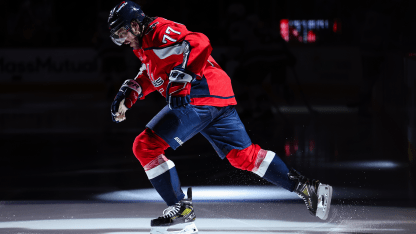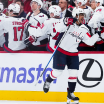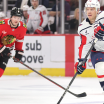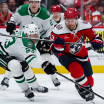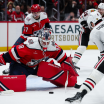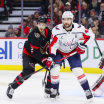Hundreds and hundreds of players have played in the NHL since began operation in 1917. But only a relative few players have had staged retirements where they are expected to say some words to an audience, which is typically comprised entirely of media in a press conference type of an environment.
When hockey players retire, the media tends to use phrases like “took off the skates for the final time” or “pulled off the sweater for the last time.” But for Caps right wing T.J. Oshie, that day happened more than a year ago. Oshie played his final game on April 28, 2024 at Capital One Arena as the Caps were eliminated from the playoffs after a 4-2 loss to the New York Rangers.
Oshie hoped to be able to play out the final season of his contract in 2024-25, but his body wouldn’t allow it. Sixteen seasons and 1,010 games – plus another 106 in the playoffs – of playing the game at full bore had taken a toll on Oshie, and he wasn’t able to find a doctor, a cure, a treatment or a drug that could enable him to squeeze even one more shift out of his 38-year-old body. And with his contract set to expire at month’s end, the time had arrived to accept that reality.
But then what?
Most players never actually “retire;” their career ends because their contract expires and they can’t find another team willing to give them another one. Occasionally, a player like Marc-Andre Fleury will make it known that he’s going to be playing his final season, allowing fans and opposing players from all around the League to pay homage as they make their way around the circuit for a final time.
Joe Pavelski retired via a two-page letter last summer, several weeks after his final game. Zdeno Chara waited until the start of training camp following his final season to pull the pin. Players such as Patrick Marleau and Joe Thornton waited for more than a full season to pass without a contract before giving up the ghost. Phil Kessel is still reported to be holding out hope; he played every single game for the last 10-plus seasons of his career, but he hasn’t played since ’22-23. He also hasn’t announced his retirement.
It's an extremely difficult decision to come to and to make. For most, hockey is all they’ve ever known, the most fun and best “job” they’ll ever have, and they’re determined to hold on for as long as possible. They know the decades of post-retirement life tend to last much longer than hockey careers.
A player’s career is similar to a beloved pet’s lifespan; it’s extremely finite, and it never lasts long enough.
“It’s just like anything,” said Oshie last year. “When you’re young, you think you’re going to play forever and it’s going to be amazing. And when you get older, you just never know.”
Mode of retirement is a personal choice, and for most hockey players, the choice is to avoid sitting or standing behind a microphone and fielding questions from the media on one of most emotional days of one’s life. Hockey players don’t play games for the media. They play them for their teams, for their teammates, for their families, and for their fans.
Once Oshie decided the time had come for him to make it official and call it a career, some dialogue took place between the player and the organization. Time was taken to consider what might be an appropriate time and method for him to do so.
And ultimately, the element of “place” came into consideration as well. Since the announcement would be made on Monday, June 9 – the seven-year anniversary of the day Oshie and his teammates frolicked in the fountain with the Stanley Cup two days after they won it in Vegas – the idea was hatched to hold the celebration outside, at Georgetown’s Washington Harbour, near that same fountain. Family, friends, teammates, and plenty of fans were on hand to help Oshie mark the occasion, and he eventually stepped to the podium with his speech in hand.
“Seven years ago today, me and my teammates were swimming in that fountain, celebrating an amazing time in our careers,” he began.
“On July 2, 2015, I got a call from St. Louis Blues GM Doug Armstrong telling me I’d been traded to the Washington Capitals,” Oshie continued. “It’s great now. At the time, there was a feeling like I had let down a city and an organization, being on so many good teams and never finding a way to win the Stanley Cup.
“I was nervous, scared – how could I leave a team of trainers and players and fans who I loved so much? And I’d say that weight was probably with me for the rest of the summer. But most of that weight was lifted a couple minutes after my call with Doug Armstrong, when I got a call from [then-] Capitals GM Brian MacLellan. Mac, you’re a man of few words. But in just minutes, you made me feel just how excited the Capitals were to have me. Thanks for your belief in me; it changed my life.”
That’s a two-way street. Oshie changed the Caps’ life, too.
“We had been looking for a right wing to play with Ovi and Nick,” reflected MacLellan, years later. “That was our goal, whether by trade or free agency. We talked to St. Louis at the draft about trading for Oshie. And we had a couple of conversations back and forth, made a couple of offers. It didn’t materialize at the draft floor, so we thought it was over, and we weren’t going to be able to do that. We ended up getting Justin Williams in free agency to fill that hole. And then the next day, St. Louis re-engages with us, and then we accomplish the deal. So it was funny in that we thought we lost Oshie, or we couldn’t get him, and we grabbed Justin Williams to fill that spot. And then we ended up getting Oshie, which was a couple of good gets.”
The trade came in the wake of the best two of Oshie’s seven seasons in St. Louis, and less than a year and a half after he dazzled the hockey world with his shootout exploits against Sergei Bobrovsky and the Russians at the 2014 Olympic Games in Sochi.
“Obviously, I have bad memories of when he beat us in the shootout in the Olympic Games,” recalls Caps captain Alex Ovechkin. “But I was kind of surprised when we make a trade and he came to the Caps. And I knew the skill he would bring would be tremendous, but I didn’t know him as a person, and I didn’t know how he was going to react in the locker room.
“But I’ve never seen a guy like him. He’s always smiling, always making a joke, and makes funny a lot of different categories. And I think he is honest. And same as John [Carlson], he cares about the boys, and he cares about the organization a lot. He is a warrior. He gives you everything he has out there. And he is so good with the puck; he is basically like Backy out there. He can make a sauce pass, and you can see what he can do with the puck. He can dangle; how many times do you see him dangle guys 1-on-1 and then find someone else [with a pass]? Skill wise, he is one of the top guys.”
Oshie scored a career high 26 goals in his first season in Washington, and he obliterated that personal best with 33 goals the following season, in 2016-17. In seven seasons with the Blues, Oshie amassed 23 power-play goals. He netted 18 with the extra man in his first two seasons in Washington.
“I think it’s the energy he brings to the game, the compete level, and then he has the skill to go with it,” said MacLellan. “He is smart enough and skilled enough to play with [Evgeni Kuznetsov] or Backy and Ovi. I think it was such a perfect fit, the way he battles for pucks, the way he finds loose pucks, and he still has the ability to play give-and-go with the high-end guys. And I think that power play spot – that diamond spot – for him was perfect, which I don’t think he had in St. Louis. So I think that added a lot, and it took his game to another level offensively, in my mind, where he took advantage of that and learned how to play it. And he scored a lot of goals there, too.”
He did. After lighting the lamp 110 times in 443 games with the Blues, Oshie scored 192 goals in 567 games as a Capital. Although four of the highest shots/60 rates of his career came during his seven seasons in St. Louis, Oshie became a much more accurate shooter in Washington (17 percent shooting pct.) than in St. Louis (11.8 percent).
“I don’t think his potential was unlocked in St. Louis as much as it was once he got here,” says Carlson. “I also think that one of his biggest assets is how he can do everything very well. He’s a very effective player – defensively, offensively, special teams. And he can bring a physical presence. He is an energy guy with skill, and you don’t have many of those in the League.
“You didn’t know what you were getting, in a good way. He is a smart guy and he knows the game, and he knows what the team needs at a given time. He is always morphing into whatever the game calls for. He reads the situations well, he reads the score, the flow, the feeling. And he’s on the bench with us too, so he knows what we’re feeling like and what the morale is like. Do we need to settle down? Do we need to be mature? Do we need to go gangbusters?”
“He’s got that personality that likes to have fun, and that kind of fits with the feeling in the room that we have and we had before he got here. Certainly, from that standpoint, he fit in perfectly. And on the ice was the least of anyone’s worries for sure. He can play with a whole slew of different players in different situations, too, and that’s just who he is.”
But it wasn’t just the goals and the shot accuracy and the superb complementary work skating with Ovechkin and Backstrom. Oshie was a warrior who would do anything to win a hockey game, anything to have an impact on a hockey game, and anything to uplift his teammates.
“A hat trick against Pittsburgh in the playoffs,” says Backstrom. “Big goals in Game 6 against Tampa, the year we won [the Stanley Cup]. I can mention a lot of big memories, but one thing that stood out to me as a linemate – and I played with him a lot – was when things weren’t going his way, he would create space for other players. He would run guys; he’s a tough guy. He is a tough guy.
“When you look at him, he’s maybe not the tallest guy and maybe not the biggest. But mentally, he is one of the biggest. And as a teammate, you see that. You feel it. And that is worth so much for a team. You see it on the bench, your teammate is flying by and hitting a guy, and he’s taking him out. That’s so important. He can do it all, that’s what I’m trying to say. He is a hell of a player, and a hell of a guy to be around. He’s been perfect for me.”
Even with his frequent aches and pains, Oshie always brought his most ebullient self to the rink every day. His relentless drive and positivity were a viral presence in the locker room for a decade, lifting all in his wake.
“When I look at my career, it wouldn’t be fair to say one guy, but a handful of guys have had an impact on my career,” says Tom Wilson, a 21-year-old third-year pro at the time of Oshie’s arrival in the District in 2015. “And Osh is at the top of the list for what he does for his teammates, for how he carries himself, how he plays the game and just for his outlook on life. He is such a positive guy, and he is so much fun to have around.
“I think we’ve definitely built a positive bond in a relationship that is beyond hockey. He feels like a brother, and he has done a lot for me. He is a guy that you genuinely feel like he is always in your corner, he’s always pulling for you, and he always wants the best for his teammates.
“When he came to this organization, he made a lot of people around him better, myself included. He is a guy who doesn’t take a shift off, and he has put a lot of hard miles on his body. He just wants to win. He works his tail off every game, and he wants to be the best that he can be, and he wants the team to win at the end of the day. It’s been an honor to battle with a guy like that and to play every night with a guy like that.”
Oshie and his teammates finally reached the promised land in the spring of 2018 when the Caps won the Stanley Cup in Vegas, touching off an unforgettable summer of celebration that buried the weight they’d carried for years of falling short in the playoffs.
“For me, every year that you fall short you get a little bit hungrier and a little bit hungrier,” Oshie said ahead of the outset of that glorious playoff run of 2018. “At the time it feels like you can’t want it any more. And then you fall short again, and somehow you want it more than you did the last time.
“I know for myself – and I imagine for a lot of my teammates in here – that hunger is built over the years. You only get so many chances to make a good run at it, and I think we have another good chance here. I know we’re not the favorite, but I think come playoff time – as we know from falling off after being the top seed going in – anything can happen.”
As he concludes his NHL career, Oshie ranks 28th on the Caps’ all-time list of games played, three games back of Ken Klee (570). For a guy that far down on the franchise’s games played ledger, Oshie had maximum impact.
He ranks ninth in franchise history with 192 goals, one fewer than Dave Christian. Oshie’s 76 power-play goals as a Capital ranks fifth, 10 behind Backstrom, who has played more than 500 more games here than Oshie.
During his decade in DC, only Ovechkin (422) has scored more goals than Oshie’s 192 for the Caps, and only Ovechkin (150) has more power-play goals than Oshie’s 76.
Since the day Oshie first pulled on a Washington sweater in 2015, only four NHL players have scored 175 or more goals in the NHL with at least 75 on the power play and a shooting percentage of at least 17 percent: Leon Draisaitl, Mark Scheifele, Brayden Point and T.J. Oshie.
But Oshie also excelled away from the puck. Among all NHL forwards with at least 500 games played across the last 10 seasons, he is one of only 22 who has averaged better than 5.4 hits/60 and 2.5 or more blocked shots/60. It’s more evidence of his willingness to do whatever it takes to win.
Teammates Wilson and Nic Dowd are also among those 22 forwards willing to sacrifice their bodies in that fashion and to that degree for their teams.
“The thing that sticks out about him for me is that it’s hard not to follow someone who is willing to do all the shitty things and still have a lot of success,” says Dowd. “The difference between him and a lot of elite players in the NHL is that he is more than happy to block shots, back track, hit somebody – and to make all that an ‘A’ part of his game, along with all the talents that he has with the puck and on the power play, shooting the puck in the slot.
“Those are things that are all sexy, and people that don’t watch the game a ton appreciate about Osh. But the guys that are in the room with him, the coaching staff, management, and people around the League, they see Osh as an all-around hockey player who is highly, highly skilled, and really good on the power play. He is willing to do all the things that some high-end players aren’t willing to do for 82 games. I mean, they might do it in the playoffs because it’s the playoffs. But Osh is willing to do those things throughout the season, and I think it’s because he enjoys doing them, and because it’s fun.
“It’s fun to do things, it’s fun to hit people, it’s fun to block shots. Yeah, it’s fun to score goals, but there’s a certain rush that come with doing the hard, little things and getting complimented on them by your teammates, because not everybody wants to do them, and not everybody does them.”
Oshie was also a master of the details of the game, and it’s why he was deployed in every and any game situation. Not only was he a coach’s dream, he is also going to be remembered as a top-notch teammate, and it’s not just for what he did on the ice.
“I go back to when I signed here,” says goalie Charlie Lindgren. “He was one of the first guys that reached out to me, and I hadn’t even really met him before. Obviously, the hockey world is really small – especially in Minnesota – but I had never really been around him in Minnesota. When I signed with Washington, I got a text from a random number, and it was T.J., welcoming me to the D.C. area. When you’ve got a guy like T.J. Oshie – a true leader and one of the greatest competitors in the League – sending you a text, it’s a very welcoming feeling.
“And then I remember coming here and talking to Woody [equipment assistant Craig Leydig], who has been here for I don’t know how long, maybe 40 years, and he told me that Osh is a top-three guy of his, all-time, just his personality; he never has a bad day, and he is always so happy, and he is such a great teammate. And man, he was spot on about all of that. He is certainly one of the best teammates I’ve ever had. He is so competitive, too. When the team needs a spark, it’s always T.J. Oshie that goes out and makes that spark. He is such a 100 percent effort guy on every single shift, and I just love it.”
And although Oshie won’t be going onto the ice and sparking his teammates in that fashion anymore, there are still many players within the Washington room who’ve played with him even briefly, and who have been affected and uplifted by his energy. While Oshie won’t be around moving forward, his legacy will linger on in that room within those players.
“As a human being, for sure he is right up there at the top, with guys like Fleury and other really good guys I’ve played with,” says Caps center Dylan Strome. “I feel like what separates him is his leadership and how hard he works. When he is playing, he drags our team into the fight. And you can really see the difference when he is playing to when he is not playing for our team; I feel like it’s a pretty telltale sign. Based on those things, it’s not a shock that he got to a thousand games. Anytime a player plays like that, that’s the kind of guy players want on their team.
“I wish people on the outside could see what he had to do just to go on the ice to practice. A guy that has that much drive and determination to want to be out there for his team, I think it’s pretty impressive. He is warming up for over an hour before each time we even step on the ice for a morning skate or a practice or whatever it may be, and it only ramps up for games. He’s dealt with injuries for a long time, and it sucks that he has to go through that. But at the same time, he exemplifies such passion and commitment to hockey, and that’s part of the reason why he brings our team into the fight, because of how much we see him go through on a day-to-day basis and how hard it is just for him to get on the ice. It’s an honor to play with him.”
Ah, but for Oshie, the honor was all his.
Oshie’s retirement speech on Monday night at Washington Harbour lasted almost 20 minutes, with a few well-timed pauses to collect himself and forge ahead. Just as he had done for over a thousand games and for 16 years as a player, Oshie gutted and gritted and willed himself through it with that familiar drive and determination, and with help from those assembled to celebrate him.
Whenever Oshie paused to gather himself, the crowd responded with cheers, and those cheers kept him going until the next difficult stretch. Talking about his career, Oshie was fine. He only became emotional when the subject turned to his family or his teammates, those who mean the most to him.
“When you read it to yourself silently, you don’t get this emotional,” he quipped at one point.
When a hockey player contemplates retirement, it’s not unlike confronting one’s own mortality.
“There’s even moments in my own game when you get older and you start to think of how's it going to play out,” Oshie told me a couple years back. “And you wonder, how is your career going to finish? Are you maybe going to bounce around for a couple years? Are you going to get traded a lot? Are you going to get hurt and not be able to come back, and think, ‘Oh, I wish I would have done something,’ whether it's surgery or other things?
Now that the day of retirement has come and gone, we can say that T.J. Oshie didn’t leave as much as a fume in the tank. Everything he had in his body was left out on the ice. He broke his hand in the penultimate game of his NHL career. And although his team trailed that playoff series with the New York Rangers 0-3, Oshie exhorted the training staff to help him neutralize that painful injury long enough for him to saddle up for one more ride, which turned out to be the last one.
“That’s the funny thing; it’s not that hard on me at all,” Oshie said of that final hockey injury at the conclusion of last season. “I’ve looked forward to the next time I’ll be able to go on the ice so when it does happen, it’s harder on the people around me than it is myself.
“To me, injuries are a part of the game. It’s not something that brings me down or gets me frustrated or anything. It’s more so the team, my teammates, my family at home. It’s different than just being sore. A broken hand is like a hangnail compared to what I go through with my back.”
Oshie arrived in Washington as a 28-year-old man just under a decade ago. He and wife Lauren have raised their four children here and they’ve created countless memories together. Those memories are in progress and will continue well beyond the day years from now when Oshie and Lauren become empty nesters.
It’s the memories created “with the boys” that will now come to a screeching halt, the unique and rare camaraderie and bond between teammates who have battled and laughed and bled and ate and drank and sweated and together. It’s virtually impossible to replicate that in the 9-to-5 life, or in whatever a player chooses to do after his playing days have ended.
That’s the part of retirement that really stings, and that’s maybe the reason why players are loathe to undertake the daunting task of putting their emotions on display one last time as they leave the game. A social media post or a letter – or just quietly walking away – seems more palatable to most than what Oshie put himself through on Monday evening in Georgetown.
But T.J. Oshie never went around anything in his 16-year NHL career, he went through it. And he went through a lot.
“I wanted to stay here for a lot of reasons but mostly because of my teammates,” said Oshie in his Monday evening farewell, after recounting the remarkable story of his eight-year, fill-in-the-blanks contract extension. “Man, what an amazing ride we had. From Presidents’ Trophies, heartbreak losses and the Stanley Cup, we’ve been through it all. I’ve been lucky in my life to be part of amazing locker rooms, but the bond we have here in DC is special.
“It was an absolute privilege to go to war with you on the ice. Thirty years from now, looking back on my career and telling my grandkids about what it was like playing in the NHL, I’ll tell them that my favorite memories was my time with you, in the locker room, dinners on the road, cards on the plane, and Mario Kart in the playoffs. Those are the times I cherish most; I’ve got the tattoo right here to prove it.
“This one’s probably going to be tougher, so I’ll get through it here. Special shout out to Backy, O, John and Tom. We’ve raised our kids together, we’ve failed together, cried together, laughed together and grieved together and became champions together. You four have a special place in my heart, a bond reserved only for family. I consider you my brothers; thank you for accepting me from day one and standing by my side through it all.
“Caps fans, how can I ever thank you enough for your support of me and my family? Like my teammates, either at Cap One [Arena] or through social [media] you guys have been there every step of the way. I want you to know your support is not taken for granted; I hope I’ve made you and this city proud by the way I’ve played the game. In 2018, we celebrated in the streets together because we won the Cup together. We felt your energy and fed off it. You can’t talk about Capitals hockey without mentioning their amazing fan base. You’re a massive piece of my career and it was an absolute honor to play for you.”
The honor was all ours, Osh. All the best to you and your family.

